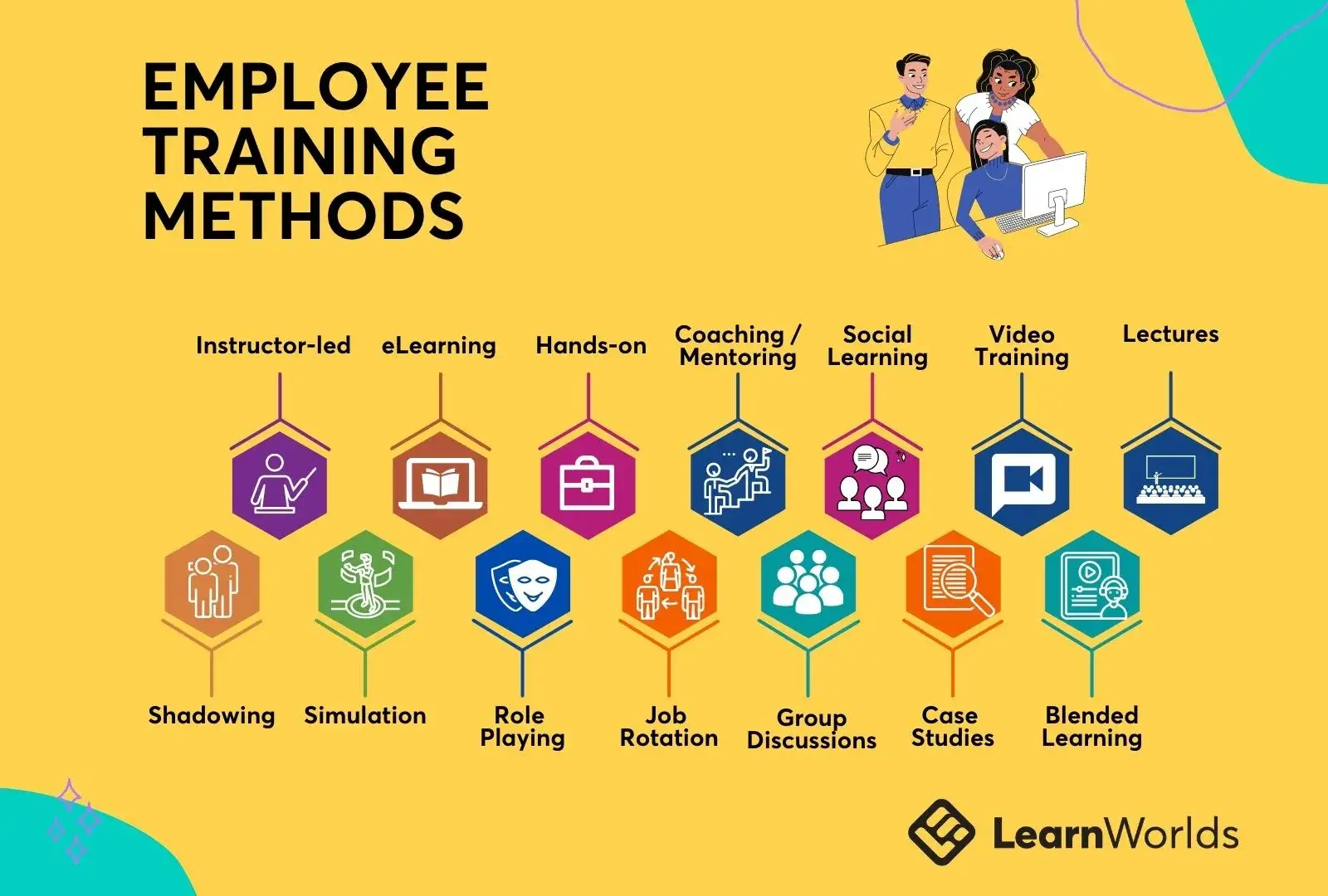Image: https://www.thehumancapitalhub.com/articles/learning-vs-development-what-you-need-to-know
Employees are the foundation of a healthy, strong, and sustainable organization (Henderson, 2017). Their strength, commitment, dedication, and emotional connection with the organization cannot always be measured in monetary values. Therefore, it is crucial for employers to provide training and development programs to their employees, which enable them to acquire new skills and update existing ones, ultimately enhancing productivity.
Importance of choosing a training method
Training and development programs are essential for both onboarding new employees and retaining existing staff members. New employees are eager to learn about the company, while existing employees are interested in extending and developing their skills. To ensure effective learning, the training method used is as important as the content and activities provided.
With advancements in modern technology, there are now more options for training and development methods than ever before. Whether an organization chooses to explore newer methods or align with traditional ones, it is critical to understand that everyone learns differently (Jayakumar1, 2016). According to the VAK Learning Styles (Barbe, 1979), there are three major learning styles:
- Visual Learning Style: This style prefers information that is seen or observed, such as pictures, diagrams, demonstrations, displays, handouts, films, and flip charts. Individuals with this preference learn best by reading instructions or watching someone else perform a task. They are also inclined to work from lists and written directions.
- Auditory Learning Style: This style prefers the transfer of information through listening, including spoken words of self or others, as well as sounds and noises. Individuals with this preference learn best by listening to instructions from an expert. They may also prefer spoken instructions over the telephone and have a good ability to remember words to songs they hear.
- Kinaesthetic Learning Style: This style prefers physical experiences, such as touching, feeling, holding, and engaging in practical, hands-on activities. Individuals with this preference learn best by trying out tasks and learning as they go.
It's important to note that individuals may not possess exclusively one single style or preference, as learners often use all three methods to receive information. However, one or more of these receiving styles is typically dominant in each individual."
Different type of training Methods
In today's competitive business landscape, organizations recognize the importance of investing in the professional growth and development of their employees as a key driver of success (Goldsmith, 2019). Effective training and development methods are crucial in equipping employees with the necessary skills, knowledge, and abilities to excel in their roles and contribute to the overall success of the organization (Noe, 2017).
- One impactful training and development method is Instructor-Led Training (ILT), also known as classroom training, where a qualified instructor delivers training sessions in a classroom setting (Noe, 2017). ILT provides employees with the opportunity to interact with the instructor and fellow learners, ask questions, and receive immediate feedback, creating an engaging and interactive learning experience.
- E-Learning has gained immense popularity due to its flexibility and accessibility (Goldsmith, 2019). It involves using digital technologies to deliver training content, such as online courses, webinars, and interactive multimedia modules. E-learning allows employees to learn at their own pace, on their own schedule, and from anywhere with an internet connection, providing a dynamic and personalized learning experience.
- On-the-Job Training (OJT) is a method that involves employees acquiring new skills and knowledge while performing their regular job tasks (Noe, 2017). It typically involves shadowing experienced colleagues or mentors, who provide guidance, feedback, and support. OJT allows employees to learn in a real-world context, applying what they learn immediately, and gaining practical experience that is directly relevant to their job responsibilities.
- Simulations and Role-Playing are effective methods for developing skills in a safe and controlled environment (Goldsmith, 2019). Simulations involve creating realistic scenarios that allow employees to practice skills or solve problems, while role-playing involves employees acting out different roles or scenarios to practice skills such as communication, negotiation, or conflict resolution. Both methods provide hands-on practice, allowing employees to refine their skills, build confidence, and learn from their mistakes.
- Mentoring and Coaching are powerful methods for employee development that involve pairing employees with experienced mentors or coaches who provide guidance, feedback, and support (Noe, 2017). Mentors and coaches offer valuable insights, share their knowledge and experience, and provide ongoing support to help employees develop their skills and capabilities. Mentoring and coaching relationships can be formal or informal and can be structured to address specific development goals or areas of improvement.
- Job Rotation and Job Enrichment are methods that involve employees taking on different roles or responsibilities within the organization (Goldsmith, 2019). Job rotation allows employees to gain exposure to different functions or departments, broaden their perspective, and develop a holistic understanding of the organization. Job enrichment involves adding more challenging tasks or responsibilities to an employee's current job, providing them with opportunities to learn and grow within their role. Both methods can enhance employees' skills, knowledge, and job satisfaction, while also increasing their value and versatility within the organization.
- Self-Directed Learning is a method that empowers employees to take ownership of their own learning journey (Noe, 2017). It involves employees setting their own learning goals, choosing resources, and managing their learning process. Self-directed learning encourages employees to be proactive, curious, and continuous learners, allowing them to acquire new skills and knowledge based on their individual needs and interests. It can involve a variety of learning approaches, such as reading books or articles, watching videos, attending webinars or workshops, or participating in online communities.
Image: https://www.learnworlds.com/training-methods/
Choosing an Appropriate Training Method
Image: https://elearningindustry.com/how-choose-training-methods-for-employees
Choosing the right employee training method requires careful consideration of various factors, including the learning objectives, the employees' learning styles, the organization's resources, and the specific context of the training. Here are some steps to guide you in choosing the right employee training method:
1. Identify Learning Objectives: Start by clearly defining the learning objectives or outcomes you want to achieve with the training. What skills, knowledge, or abilities do you want employees to acquire or improve upon? Understanding the desired learning outcomes will help you select a training method that aligns with those objectives.
2. Consider Learning Styles: Consider the learning styles of your employees. Some employees may prefer hands-on activities, while others may prefer more self-paced learning or group discussions. Understanding the learning styles of your employees can help you choose a training method that caters to their preferences and enhances their learning experience.
3. Assess Resources: Evaluate the resources available to your organization, including budget, time, and technology. Some training methods may require significant financial investment, such as instructor-led training or e-learning platforms, while others may be more cost-effective, such as on-the-job training or job rotation. Consider the availability of time and resources to implement and sustain the chosen training method.
4. Consider the Context: Consider the specific context of the training, including the nature of the job roles, the level of expertise of the employees, and the organizational culture. For example, simulations and role-playing may be more suitable for developing soft skills, such as communication or leadership, while on-the-job training may be more effective for technical skills. Consider the organizational culture and whether the chosen training method aligns with the values and practices of the organization.
5. Evaluate Effectiveness: Review the effectiveness of the training method based on evidence and research. Look for studies or data that support the effectiveness of the chosen training method in achieving the desired learning outcomes. Consider feedback and testimonials from other organizations or professionals who have used the training method.
6. Flexibility and Adaptability: Choose a training method that can be adapted to the changing needs of your organization and employees. The business landscape and employee development needs may evolve over time, so it's important to choose a training method that is flexible and can be modified as needed.
7. Employee Feedback: Consider gathering feedback from employees to understand their preferences and needs when it comes to training. Employees may have valuable insights on what methods they find most effective or engaging. Involving employees in the decision-making process can increase their buy-in and motivation for training.
Conclusion
In conclusion, training and development methods are essential for organizations to enhance employee performance and drive organizational success. By investing in these methods, organizations can create a culture of continuous learning and development, where employees are empowered to acquire new skills, grow professionally, and contribute to the success of the organization. Also, by considering learning objectives, learning styles, resources, context, effectiveness, flexibility, and employee feedback, you can choose the right employee training method that best fits your organization's needs and enhances the development of your employees. As the saying goes, "The only thing worse than training employees and losing them is not training them and keeping them." So, invest in your employees' growth, and watch them thrive!
References
Barbe, W. B., 1979. Learning style inventory. , s.l.: Western Psychological Services.
Goldsmith, M. L. L. &. M. S., 2019. Coaching in Organizations: Enhancing Performance for Individuals and Teams, s.l.: Routledge.
Henderson, R., 2017. Effective Human Resource Development: Learning, Training, and Development for Improved Performance, s.l.: Kogan Page Publishers.
Jayakumar1, N., 2016. Learning styles and the factors affecting learning: a study in Malaysia. , s.l.: Journal of Education and Learning, 5(2), 286-292..
Noe, R. A., 2017. Employee Training and Development, s.l.: McGraw-Hill Education.
Association for Talent Development (ATD). (2019). 2019 State of the Industry Report. Retrieved from https://www.td.org/research/2019-state-of-the-industry-report
Allen, M. W. (2016). Michael Allen's Guide to E-Learning: Building Interactive, Fun, and Effective Learning Programs for Any Company. Wiley.
DeRosa, D. M. (2019). The Effectiveness of On-the-Job Training in Organizations: A Meta-Analysis. Human Resource Development Review, 18(4), 470-499.
Salas, E., Tannenbaum, S. I., Kraiger, K., & Smith-Jentsch, K. A. (2012). The Science of Training and Development in Organizations: What Matters in Practice. Psychological Science in the Public Interest, 13(2), 74-101.
Higgins, M., & Thomas, G. (2001). Using a Role Play Assignment to Teach Group Counseling Skills. Counselor Education and Supervision, 41(3), 189-197.
Gaskin, J. (2015). Mentoring and Coaching in Schools: Professional Learning Through Collaborative Inquiry. Springer.
Hackman, J. R., & Oldham, G. R. (1976). Motivation Through the Design of Work: Test of a Theory. Organizational Behavior and Human Performance, 16(2), 250-279.
Knowles, M. S. (1975). Self-Directed Learning: A Guide for Learners and Teachers. Association Press.




Insightful explanation on training & development methods Prasad. Chitra, R. (n.d) pointed out that not only advantages there are some disadvantages as well of T&D programs to the company. 1. Wastage of time and money: Since the company must spend money, time, and hire more personnel for training, there is unquestionably a waste of precious resources. They also have to cover the trainer's and the employees' salaries.
ReplyDelete2. Increased stress: Training personnel for a greater number of hours might cause tension because it keeps them current on the newest trends and competent in their particular field. They may do less well at work as a result of their stress.
3. Training programs for some departments focus too much on theory rather than application. Employees find it challenging to learn the material after listening to these presentations.
4. Loss of interest: When training sessions last for a long time, the participants get bored and lose interest. Therefore, data and information are not kept for workers who do not listen. Employees lose interest in training sessions when the same information or theory is repeated continually.
5. Quit for a new position: When an employee has received training and is equipped with the most recent information and abilities. They are prepared and eager to join a different company that provides respectable benefits and pay.
6. Time requirements: Given the daily hectic schedule, staff training may not have enough time is one of the other major disadvantages of employee training.
Many companies provide employees extremely little time, which might not help them become knowledgeable or productive. The trainer typically raced over the key components of the job that employees need to understand because they had so little time.
7. Maintaining control over training: If the task of onboarding new employees has been given to another trainer or employee, you must keep an eye on what they are learning.
The employees might pick up certain undesirable habits and receive instruction that is of lower quality because the trainer may not be as skilled and talented as you. This would jeopardize the entire training. Thus, having effective control over training is essential.
Thank you Piumi for your valuable comment. Very True. But I trust that while there may be some drawbacks to training and development (T&D) programs, the benefits of a skilled workforce outweigh the disadvantages. Properly designed and implemented T&D programs can lead to increased productivity, reduced stress, practical application of learning, employee retention, strategic scheduling, and effective control over training quality. Thus, the long-term advantages of T&D programs justify the initial investment of time and resources.
DeleteVisual, auditory, and kinaesthetic, are discussed. It is crucial to remember that learners frequently employ all three approaches to obtain information, and a combination of these can aid in delivering good training. The article discusses other training approaches, such as instructor-led training, e-learning, on-the-job training, simulations and role-playing, mentoring and coaching, work rotation and job enrichment, and self-directed learning. Each method has distinct advantages, and employers must choose the best training method for their staff depending on their learning styles and needs.
ReplyDeleteIt would be valuable to explore how organizations can measure the success of their training programs and adjust them accordingly to ensure continuous improvement.
I completely agree with your point on the importance of measuring the success of training programs and continuously improving them. According to research, measuring the effectiveness of training programs is crucial for organizations to ensure that they are achieving their desired outcomes and achieving a return on investment. One effective way to measure training success is to use Kirkpatrick's four-level model, which evaluates the training program's effectiveness in terms of reaction, learning, behavior, and results (Kirkpatrick, 1994). By using this model, organizations can identify areas for improvement and adjust their training programs accordingly to ensure that they are meeting their objectives and improving employee performance.
DeleteYou have analyzed some very valuable ideas. Organizations should have a good understanding of how to measure the success of their training programs. As you said, it is important to give training that changes at least every two months. Objectives can be achieved through continuous training improvements. A valuable creation.
ReplyDeleteThis article presents useful information on the importance of employee training and development programs, as well as different training methods. The article emphasises that the training method used is as important as the content and activities provided. The VAK Learning Styles are also discussed, highlighting the fact that individuals learn differently and possess different learning styles. The article provides a comprehensive list of training methods to help organisations choose the most suitable approach for their employees. My question for you Prasad, how can organisations ensure that their training and development programs are effective and have a positive impact on their employees and the overall success of the organisation? Keen to know your thoughts.
ReplyDeleteA well descriptive article.
ReplyDeleteAn effective training and development method is important because it can improve employee performance and ultimately increase the productivity. According to a study by the Association for Talent Development (ATD), companies that invest in employee training and development have a 24% higher profit margin than those that do not. An effective training and development method is crucial for organizations that want to improve employee performance, retain their workforce, and stay competitive in today's rapidly changing business environment.